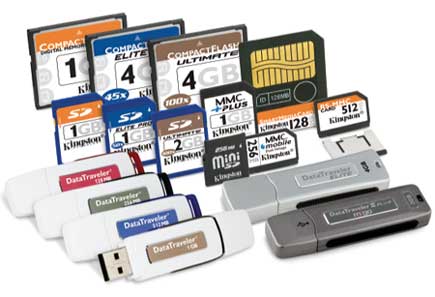Digital Media Guide; Portable digital media for computers, digital cameras, and other devices
Note: Due to flash technology changes, specifications listed in this document are subject to change without notice.

1.0 Flash Memory: Empowering A New Generation of Flash Storage Devices
Toshiba invented flash memory in the 1980s as a new memory technology that allowed
stored data to be saved even when the memory device was disconnected from its
power source. Since then, flash memory technology has evolved into the
preferred storage media for a variety of consumer and industrial devices.
In Consumer Devices, Flash Memory Is Widely Used In:
· Notebook computers
· Digital cameras
· Personal Digital Assistants (PDAs)
· Electronic musical instruments
· Global Positioning Systems (GPS)
· Cellular telephones
· Solid-state music players such as MP3 players
· Television set-top boxes
· Pagers
· Personal computers
Flash memory is also used in many industrial applications where reliability
and data retention in power-off situations are key requirements, such as in:
· Security systems
· Military systems
· Embedded computers
· Solid-state disk drives
· Networking and communication products
· Wireless communication devices
· Retail management products (e.g., handheld scanners)
· Medical products
2.0 Flash Card or USB Flash Drive Capacity
Some of a flash storage device's listed capacity is used for formatting
and other functions and thus is not available for data storage.
When a flash storage device is manufactured, steps are taken to ensure that
the device operates reliably and to permit the host device (computer, digital
camera, PDA, etc.) to access the memory cells -- i.e., to store and retrieve
data on the flash storage device. These steps -- loosely called "formatting"
-- utilize some of the memory cells within the device and thus reduce the
capacity available for data storage by the end-user.
Formatting includes the following operations:
1. Testing each memory cell in the flash storage device.
2. Identifying all defective cells and taking steps to ensure that no data will
be written to or read from a defective cell.
3.Reserving some cells to serve as "spares." Flash memory cells
have a long but finite lifetime. Therefore, some cells are held in reserve to
replace any memory cells that may fail over time.
4.Creating a File Allocation Table (FAT) or other directory. To enable flash
storage devices to conveniently store and access customer files, a file management
system must be created to allow any device or computer to identify the files
stored in the
flash storage device. The most common type of file management system for flash
storage devices is the File Allocation Table (FAT), which is also used on hard
drives.
5.Reserving some cells for use by the flash storage device's controller,
e.g., for storing firmware updates and other controller-specific information.
6.Where applicable, reserving some cells for special features. For example,
the specification for Secure Digital (SD) cards requires reserved areas to support
special copy protection and security features.
3.0 Features of Kingston's Flash Storage Products
Kingston's flash storage devices offer many advantages for both consumer
and
industrial applications:
· Flash Storage Device Warranty: Kingston warrants that
its flash storage devices are free from defects in material and workmanship
for the period specified below:
· CF, SD, SM, MMC Flash Cards: Lifetime
· DataTraveler® USB Flash Drives: 5 years
For further details, see kingston.com/company/warranty.asp
· Digital Media Reader-Writer Five-Year Warranty: Kingston's
line of digital media reader-writers come with a five-year warranty from defects
in material and workmanship. The PC Card 4/1 reader-writer comes with a two-year
warranty. For
further details, see kingston.com/company/warranty.asp
· Solid State: Flash storage devices, as semiconductor
storage devices, have no moving parts and thereby are not subject to the mechanical
failure issues of hard drives. Their overall data reliability enabled them to
dominate the convenienceoriented
portable memory products market, operating silently with a zero decibel noise
level.
· Small Physical Size (or Form Factor): Flash storage
devices are designed to be easily transported. Convenience is an important criterion,
especially for consumer and corporate applications.
· High Data Reliability: Flash memory is very reliable
and many of the flash storage device types also include Error Correction Code
(ECC) checking to detect singlebit errors. For example, Kingston's CompactFlash
cards have a rated error
specification of less than one (1) bit in 1,000,000,000,000,000 bits read (1
bit per 1015 bits read).
· Kingston Flash Data Retention: Kingston flash storage
devices are rated for up to 10 years under normal use. Important information
should also be backed up on other media for long-term safekeeping.
· Wear-Leveling Technology: Kingston flash storage devices
(excluding SmartMedia cards) incorporate controllers utilizing advanced wear-leveling
technology, which distributes write cycles across the flash card. Wear-leveling
thus extends the useful
life of a flash memory card (for details, please see Kingston Flash Cell Endurance
section, next).
· Flash Cell Endurance: Up to 10,000 Multi- Level Cell
(MLC) Flash or up to 100,000 Single-Level Cell (SLC Flash) write cycles per
physical sector.
According to Toshiba, the inventor of flash memory: "the 10,000 cycles
of MLC NAND is more than sufficient for a wide range of consumer applications,
from storing documents to digital photos. For example, if a 256MB MLC NAND Flashbased
card can typically store 250 pictures from a 4-megapixel camera (a conservative
estimate), its 10,000 write/erase cycles, combined with wear-leveling algorithms
in the controller, will enable the user to store and/or view approximately 2.5
million pictures within the expected useful life of the card.
For USB flash drives, Toshiba calculated that a 10,000 write cycle endurance
would enable customers to "completely write and erase the entire contents
once per day for 27 years, well beyond the life of the hardware."
SLC flash based-products, typically found in Kingston's Elite Pro cards
and DataTraveler 2.0 USB flash drives, offer both high-performance and highendurance.
- Log in or register to post comments

































